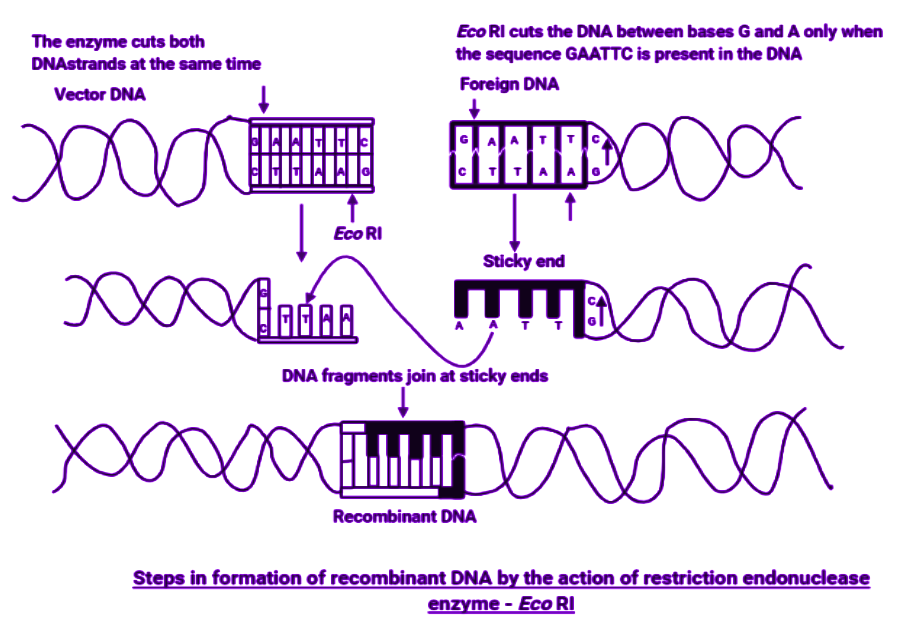
Eco Rl is used to cut a segment of foreign DNA and that of a vector DNA to form a recombinant DNA. Show with the help of schematic diagrams.
(i) The set of palindromic nucleotide sequences of base pairs the EcoRI-will recognize in both the DNA segments. Mark the site at which Eco RI will act and-cut both the segments.
(ii) Sticky ends formed on both the segments where the two DNA segments will join later to form a recombinant DNA.
Answer
479.7k+ views
Hint: In recombinant DNA technology, the restriction enzyme is used as a molecular scissor or micro scissors or chemical knife to cut the foreign or donor DNA. It is site-specific and makes internal cuts in double-stranded DNA molecules at particular nucleotides with palindrome sequence.
Complete answer: Eco RI is a restriction endonuclease enzyme that is obtained from E.coli species. It is a restriction enzyme that cuts double-stranded DNA into fragments at a particular site. Eco RI cuts GAATTC sequences.
-It creates sticky ends of four nucleotides with 5’ end overhangs of AATT. The recognition sequence of nucleic acid where this enzyme will cut is G/AATTC, which is a palindrome having a complementary sequence of CTTAA/G. The sign '/' indicates which phosphodiester bond in a DNA molecule this enzyme will break.
The diagram given below shows the action of Eco RI on the double-stranded DNA:

i. The enzyme recognizes the palindrome sequence G/AATTC and its complementary sequence CTTAA/G. The enzyme as shown in the diagram will cut the DNA strand from the arrow drawn.
ii. In the second step, after the cleaving by the enzyme the ends left have a single strand overhanging. These overhangs will easily combine with the other overhang formed and thus are known as sticky ends. The process is shown in the diagram.
Note: Eco RI is a type of restriction enzyme that cleaves the double-stranded DNA molecule into fragments from a particular site. The recognition sequence from which this enzyme will cut is a palindrome GAATTC. After cleaving the strands there is a formation of sticky ends which will combine easily to form recombinant DNA.
Complete answer: Eco RI is a restriction endonuclease enzyme that is obtained from E.coli species. It is a restriction enzyme that cuts double-stranded DNA into fragments at a particular site. Eco RI cuts GAATTC sequences.
-It creates sticky ends of four nucleotides with 5’ end overhangs of AATT. The recognition sequence of nucleic acid where this enzyme will cut is G/AATTC, which is a palindrome having a complementary sequence of CTTAA/G. The sign '/' indicates which phosphodiester bond in a DNA molecule this enzyme will break.
The diagram given below shows the action of Eco RI on the double-stranded DNA:

i. The enzyme recognizes the palindrome sequence G/AATTC and its complementary sequence CTTAA/G. The enzyme as shown in the diagram will cut the DNA strand from the arrow drawn.
ii. In the second step, after the cleaving by the enzyme the ends left have a single strand overhanging. These overhangs will easily combine with the other overhang formed and thus are known as sticky ends. The process is shown in the diagram.
Note: Eco RI is a type of restriction enzyme that cleaves the double-stranded DNA molecule into fragments from a particular site. The recognition sequence from which this enzyme will cut is a palindrome GAATTC. After cleaving the strands there is a formation of sticky ends which will combine easily to form recombinant DNA.
Recently Updated Pages
Master Class 12 Business Studies: Engaging Questions & Answers for Success

Master Class 12 English: Engaging Questions & Answers for Success

Master Class 12 Social Science: Engaging Questions & Answers for Success

Master Class 12 Chemistry: Engaging Questions & Answers for Success

Class 12 Question and Answer - Your Ultimate Solutions Guide

Master Class 12 Economics: Engaging Questions & Answers for Success

Trending doubts
Give 10 examples of unisexual and bisexual flowers

Draw a labelled sketch of the human eye class 12 physics CBSE

Differentiate between homogeneous and heterogeneous class 12 chemistry CBSE

Write a short note on Franklands reaction class 12 chemistry CBSE

Differentiate between insitu conservation and exsitu class 12 biology CBSE

What are the major means of transport Explain each class 12 social science CBSE




